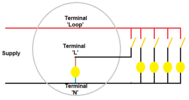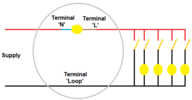A simple "Are you busy? Upstairs lights have stopped working".
Customer insists nothing has been done, judging by the amount of dust in the lampshade and dead bugs in the rose I feel it is genuine:
 For clarity that's one red in 'N', 4 blacks in 'LOOP' and 3 reds in 'L'. My instant guess being this is a total L & N reversal. I unhooked the flex and started loosening the rest before I took the pic.
For clarity that's one red in 'N', 4 blacks in 'LOOP' and 3 reds in 'L'. My instant guess being this is a total L & N reversal. I unhooked the flex and started loosening the rest before I took the pic.
All testing done with a LED screwdriver found 'N' is the only 'live' terminal.
2 (CFL and LED) of the other 4 lights are wired as very standard 'Loop at rose', the other 2 are a bathroom LED fitting and a brass chandelier style (yellow single wire, tested continuity to brass fitting) with 3 small looking CFL which I didn't open as they are without roses.

And the HO skirt
 contained a blown 75W bulb.
contained a blown 75W bulb.
I rewired it as standard Loop, repowered and when I switched the light on the RCBO tripped due to a damaged switch drop in the loft and I suspect this was the reason neutral switching had been attempted.
Customer insists nothing has been done, judging by the amount of dust in the lampshade and dead bugs in the rose I feel it is genuine:
All testing done with a LED screwdriver found 'N' is the only 'live' terminal.
2 (CFL and LED) of the other 4 lights are wired as very standard 'Loop at rose', the other 2 are a bathroom LED fitting and a brass chandelier style (yellow single wire, tested continuity to brass fitting) with 3 small looking CFL which I didn't open as they are without roses.
And the HO skirt
I rewired it as standard Loop, repowered and when I switched the light on the RCBO tripped due to a damaged switch drop in the loft and I suspect this was the reason neutral switching had been attempted.




